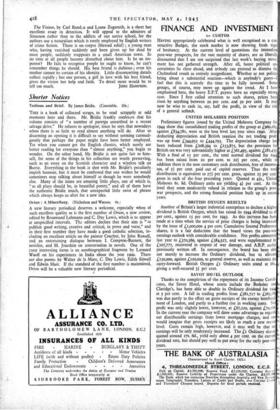FINANCE AND INVESTMENT
bv CUSTOS
HAVING appropriately celebrated what is well recognised as a con. structive Budget, the stock market is now showing fresh signs of hesitancy. At the current level of quotations the immediate post-war prospects, for the vast majority of shares, are so liberally discounted that I am not surprised that last week's buying move- ment has not gathered strength. After all, home political un. certainties lie close ahead, and nobody can pretend to dismiss the Chelmsford result as entirely insignificant. Whether or not politics bring about a substantial reaction—which is anybody's guess—I feel that this is scarcely the time to be fully invested. Some groups, of course, may move up against the trend. A'S` I have emphasised here, the heavy E.P.T. payers have an especially strong case. Since I first called attention to such shares, prices have risen by anything between 20 per cent. and 5o per cent. It may now be wise to cash in, say, half the profit, in view of the risk of a general setback.
UNITED MOLASSES POSITION
Preliminary figures issued by the United Molasses Company for 1944 show that consolidated trading profits of the group at £960,163, against £834,781, were at the best level last year since 1940. After deducting depreciation and British taxation the net trading profit was up from £344,952 to £444,793. The depreciation charge has been reduced from £208,394 to £153,875, but the -provision for British tax was very substantially higher at k361,495, against £281,435 With a final of 15 per cent., the total normal dividend for 19 has been raised from 20 per cent. to 224 per cent., while in addition there is the now customary cash distribution, free of income tax, of 24 per cent. paid out of capital reserves. Thus the total distribution is equivalent to 274 per cent. gross, against 25 per cent gross in each of the four preceding years. Quoted at 43s., United Molasses 6s. 8d. Ordinary units are yielding 44- per cent. At thi level they seem moderately valued in relation to the group's post- war prospects, and the strong financial position built up in recen y ears.
BRITISH OXYGEN RESULTS Another of Britain's larger industrial enterprises to declare a higher dividend is British Oxygen, which has raised its 1944 dividend to i6 per cent., against 15 per cent. for 1943. As this increase has been made at a time when the service of prior charges is being increased by the issue of Li,000,000 4 per cent. Cumulative Second Preference shares, it is a fair deduction that the board views the post-war earnings outlook with considerable confidence. Net profits amounte last year to £370,369, against £384,527, and were supplemented bs L107,777, recovered in respect of war damage, and A.R.P. outlay previously written off. In consequence, the board has been able not merely to increase the Ordinary dividend, but to allecat £15o,000, against Lioo,000, to general reserve, as well as maintain the carry-forward. British Oxygen fr Ordinary units stand at 88s. giving a well-secured 3.4 per cent.
SAVOY HO TEL OUTLOOK Thanks to the completion of •the repayment of itS Income Certifi cates, the Savoy Hotel, whose assets include the Berkeley a Claridge's, has been able to double its Ordinary dividend for at 5 per cent. A fall in trading profits from £281,717 to £265,18 was due partly to the effect on gross receipts of the enemy bombard ment of London, and partly to a further rise in working costs. Ne profit was only slightly lower, however, at £67,220, against £7o,t86 In the current year the company will draw some advantage as regard net distributable earnings from lower mortgage charges, and on would imagine that gross receipts are li,kely to reach a new recor level. Costs remain high, however, and it may well be that n earnings will be only moderately increased. The Li Ordinary shar quoted around 27s. 6d., yield only about 4 per cent. on the curren dividend rate, but should pay well to put away for the early post-sv years.


























 Previous page
Previous page